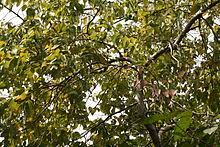Cinnamon
Scientific Name: Cinnamomum verum
Climate: Warm
Plant Description1: As a tree, it can grow up to ten meters, but usually remains smaller and more like an evergreen shrub. It has a woody trunk, and its bark, the most important part, is brown.
The leaves are oval and pointed, bright green on top, with five reddish veins. Its flowers are white or yellow and covered with hairs. The fruit is a long oval-shaped berry, about 12.5 cm, very dark, blue to black, with a single seed inside.
It is native to Sri Lanka and is also grown in Brazil, Burma, India, Indonesia, West Indies and Pacific Islands.
Cultivation: It can be reproduced either from the seeds found inside the berry or through cuttings.
If using seeds, they can be planted directly into the ground or in plastic bags, in shaded places. If it is planted directly in the soil, the beds should be about one meter wide and distributed in lines ten to 15 cm apart, then covered with a layer of soil. Germination occurs two to three weeks after sowing.
The first harvest is done when the tree is three or four years and then every two years, twice a year, between the months of May and June and in October, when the branches are more than three centimeters in diameter and their color has changed to dark green, as at this stage it can easily separate the bark from the wood.
Cinnamon requires shade and abundant watering, and adapts to well distributed annual rainfall of between 2,000 and 4,000 mm. It prefers deep, humid soils with a sandy and muddy texture, and with a high organic matter content and good drainage all year round.
 Uses: Ground cinnamon is widely used in desserts, cakes, sweets. It is commonly taken as tea. It has been used in the past to induce sleep in children, as well as to help ease menstrual discomfort and heavy menstrual bleeding.
Uses: Ground cinnamon is widely used in desserts, cakes, sweets. It is commonly taken as tea. It has been used in the past to induce sleep in children, as well as to help ease menstrual discomfort and heavy menstrual bleeding.
It has beneficial effects for diabetes and can help lower blood cholesterol and triglyceride levels as well.
Pests and Diseases: Cinnamon suffers from few serious diseases. The trunk and branches of young trees can be affected when the soil is poorly drained. The affected branches must be burned or buried.
References:
En español: Canela

